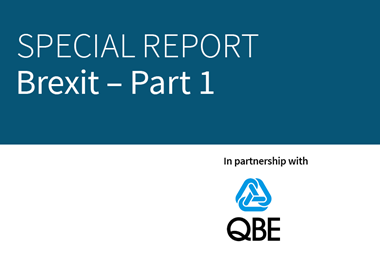Multinationals should do more to tackle legal risks around parallel imports – particularly post-Brexit, according to law firm Hogan Lovells

Multinational companies are typically not doing enough to protect their valuable trade marks against grey market parallel imports.
Uncertainty over the future regulation in this area following the UK’s Brexit decision means now is the time to consider whether you could do more to protect your trade marks.
What are grey market goods?
Grey market goods, also referred to as parallel imports, are genuine goods obtained from a market where they are being sold by the trade mark owner (or with its consent) which are later sold in a different market without the trade mark owner’s consent. The importer is usually taking advantage of cheaper pricing in a foreign market and importing goods to a domestic market where those goods are either not available, or are only available at a higher price.
The parallel importer is “freeriding” on the trade mark owner’s goodwill and is able to sell the goods without incurring the overhead costs of the trade mark owner, thereby undercutting authorised domestic distributors.
Grey market goods are legally imported and are not counterfeit goods, although there is evidence to suggest parallel imports are sometimes mixed with counterfeit goods, providing an easy route for counterfeiters.
Why are grey market goods problematic for trade mark owners?
According to the International Trademark Association, billions of dollars in revenue is lost each year to grey market diversion. Parallel imports reduce sales as well as devaluing the goodwill held in the trade mark.
The trade mark owner may lose control over the quality of the goods and after sales service experienced by the consumer and health and safety concerns may further damage goodwill and profits.
The trade mark owner’s rights are also negatively affected by grey market sales due to the doctrine of exhaustion.
Under the doctrine a trade mark owner’s rights are “exhausted” following the first authorised sale of the goods and the trade mark owner loses the right to prevent further trade in those goods.
Once a trade mark owner’s rights are “exhausted” in this way the owner’s rights can only be protected in limited circumstances (e.g. where the first sale occurred without the trade mark owner’s consent, or where there are material differences in the imported goods once offered for sale).
The doctrine of exhaustion is necessary to strike a balance between trade mark holders’ interests and the free trade of goods but favours parallel importers to a greater or lesser degree depending on whether the jurisdiction you are trading in applies the doctrine internationally or domestically.
International exhaustion means the exhaustion of intellectual property rights applies worldwide, regardless of where the first sale is made.
Domestic exhaustion only exhausts a trade mark owner’s rights in the market in which the first sale occurs. Domestic exhaustion is therefore preferable from a right-holder’s point of view and whether international or domestic exhaustion should apply in each jurisdiction is highly controversial.
The implications of Brexit
The result of the UK’s vote to leave the EU has important implications for the grey market. Before the UK joined the EU, the UK adopted a policy of international exhaustion.
As part of the free movement of goods within the EU it was necessary for all EU member states (including the UK) to adopt a policy of “regional” exhaustion, meaning once goods have been traded within the EU the owner’s right to object, based on its trade mark rights, are exhausted across all EU member states, except in specific circumstances (e.g. where the quality of the goods has been affected).
There is no doctrine of international exhaustion within the EU so the hybrid “regional” exhaustion is preferable for rights holders to international exhaustion, but not as beneficial as domestic exhaustion.
If the UK remains a member of the EU single market, post-Brexit, the policy of regional exhaustion is likely to continue to apply; however, if the UK leaves the single market we may see a return to a policy of international exhaustion for all IP rights.
This could lead to an increase in grey market trading and have a significant impact on the brand owners’ rights and profits.
A return to international exhaustion could have far-reaching consequences and if rights holders have strong preferences either way, they should consider taking action now to lobby the UK government to influence policy development.
What are trade mark owners doing to protect their rights?
Despite the significant negative impact of grey market goods on trade mark owners, the Brand Benchmarking 2016 survey carried out by Hogan Lovells found that while most international brand owners invest significant time and money in registering trade marks, 60% take little or no action in dealing with grey market parallel imports.
What can trade mark owners do to protect their rights?
Brand Benchmarking 2016 found that more than half (52%) of the 100 international brand owners surveyed cited difficulty of enforcement as their main reason for not taking action against grey market goods. Asian companies were less proactive than Western companies, with 71% taking little or no action.
There are many ways rights holders may be able to take action to mitigate the damage caused by grey market goods, for example:
• Reviewing the company’s business supply chain, licence and distribution agreements and adding provisions to prevent exports of goods to certain jurisdictions;
• Re-drafting to limit access of purchasers of grey market goods to warranties;
• Creating an internal and external policing programme to collect information on grey market activity; and
• Registering key trade marks with local customs authorities so that grey market goods that are being improperly sold can be seized. (Despite many countries having good customs seizure systems, Brand Benchmarking 2016 found that 30% of brand owners do not record trade marks with any customs authorities and only 13% do so in more than 10 countries.)
Many multinationals are foregoing valuable brand protection opportunities simply because of difficulties navigating varying enforcement regimes worldwide.
Remedies vary widely across different jurisdictions and it is therefore important that rights holders get specialised local counsel advice to make the most of the local enforcement regimes. Taking the right action at the right venue and clearly assessing and understanding the pros and cons of each procedure in each country are vital to successful brand protection.
For a copy of the Brand Benchmarking report please visit: http://ehoganlovells.com/s/459cb510fb14da12239e8057671605870b61308c
Clare Matheson is an associate at Hogan Lovells International LLP




















No comments yet